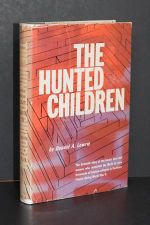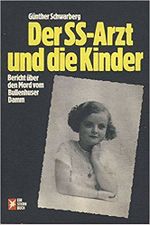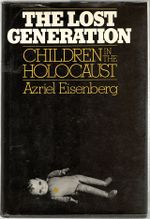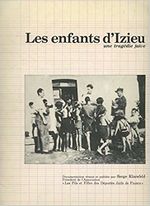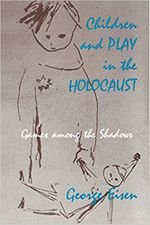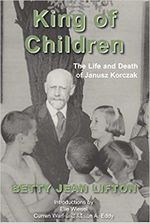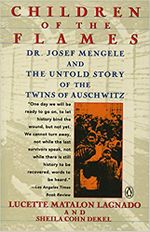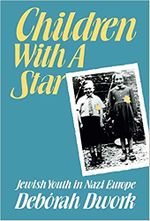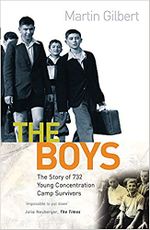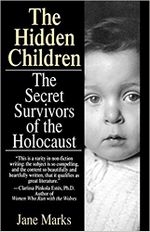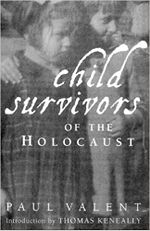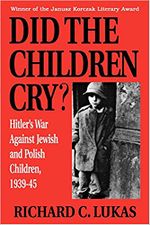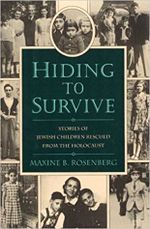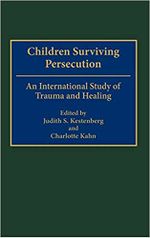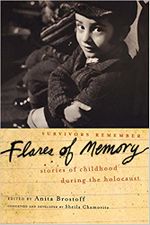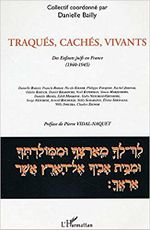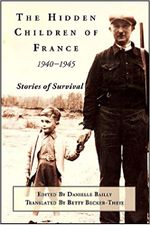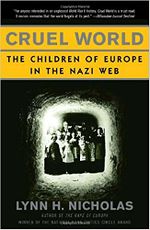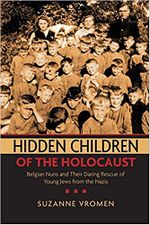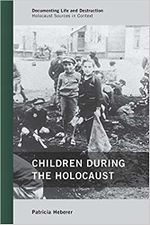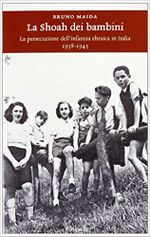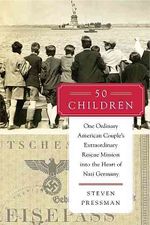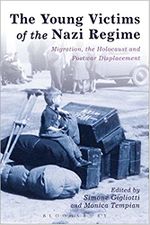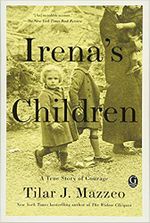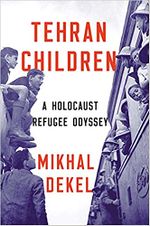Category:Holocaust Children (subject)
Bibliography
1930s
1934
Violet Bonham Carter. Child Victims of the New Germany: A Protest (London: McCorquodale, 1934)
"From a speech delivered in London on December 20th, 1933." Includes appendix: Jewish children in Germany: A dossier of cruelties and humilitations.
Violet Bonham Carter (1887-1969) - The daughter of H. H. Asquith, Prime Minister from 1908–1916, was a British politician and diarist. Along with Winston Churchill (and others), she very early on saw the dangers of European fascism. In seeking to awaken Britain and the world to the fascist peril, she joined and animated a number of anti-fascist groups (such as The Focus Group), often in concert with Churchill, and spoke at many of their gatherings. On one of these occasions she offered one of the earliest denunciations of the persecution of children in Nazi Germany.
1940s
1947
- Benjamin Tennebaum, ed., Ehad me-ir u shenayim mi-mishpahah: Mivhar m’elef autobigrafiot shel yaldei Yisrael b’Polin [One of a City and Two of a Family: A Selection from a Thousand Autobiographies of Jewish Children in Poland] (Merhavyah, Israel: Sifriat Poalim, 1947) <Hebrew>.
- Maria Hochberg-Marianskwa and Noe Grüss, eds. Dzieci Oskarzaja (Cracow-Łódź-Warsaw: Central Jewish Historical Commission in Poland, 1947) <Polish>. English tr. The Children Accuse (London: Vallentine-Mitchell, 1996)
This most unusual book contains evidence collected by the author in 1945 in Poland from children and teenagers who surfaced from hiding in forests and bunkers and told the story of their survival as it happened. The interviews, expertly translated from the original Polish, document life in the ghettos, the camps, in hiding, in the resistance and in prison. There is also a series of interviews with adults who lived and worked alongside children in wartime Poland.--Publisher description.
- Noe Grüss (Noah Gris), ed. Kinder-martirologye: zamlung fun dokumentn [Children’s Martyrdom: A Document Collection] (Buenos Aires [Argentina]: Tsentral-farband fun Poylishe Yidn in Argentine, 1947) <Yiddish>
"The future of surviving children was a major issue in post-Holocaust Jewish society ... Less known is the fact that correspondingly, much effort was put into listening to the child survivors, recording their stories, and publishing them. By 1947 three anthologies of children’s testimonies were published [in Israel, Poland, and Argentina] bringing to the public the stories of child survivors as they told them." Some children's testimonies were also collected and published in the Yiddish journal Fun Lezten Hurban, the first-ever Holocaust research journal, published in Munich during 1946– 48. The journal was published by the Central Historical Commission in Munich, which was established in December 1945 by the Central Committee for the Liberated Jews in Germany. The commission collected thousands of testimonies from Holocaust survivors in the DP camps, among them hundreds from child survivors of the Holocaust. The drive to collect testimonies from children was initiated by Israel Kaplan (1902–2003), a teacher from Kovno who together with Moshe Feigenboim led the commission. The child survivors and their stories held a strong fascination with Kaplan, whose own child survived the Holocaust in hiding and on the run. Out of hundreds of testimonies collected from child survivors by the staff of the Central Historical Commission during its more than three years of existence, eight were selected for publication in the journal issues."--See Boaz Cohen, Representing Children's Holocaust
1948
Lena Küchler-Silberman. Mayne Kinder (Paris: Aroysgegebn durkhn Yidishn folksfarband in Frankraykh, 1948) <Yiddish>.
My Hundred Children (London : Souvenir Press; and Garden City, NY: Doubleday, 1961).
Also translated into Hebrew (1959).
"The author recounts how she led a hundred Jewish orphans out of postwar Poland to safety in Israel"--Publisher description.
Lena Küchler-Silberman (1910-1987) was a Jewish teacher, educator and psychologist. She was born and grew up in Wieliczka, Poland. After completing her studies in the Hebrew gymnasium in Kraków she went on to study philosophy, psychology and pedagogy. During the Holocaust, she lived as a alias outside the Warsaw ghetto, being able to smuggle several children out of the ghetto. After the war, she travelled to the Jewish council in Krakow where she met young children who had lost their families. She took them in, giving them a home in a house she found in Zakopane. From there they made their way to Czechoslovakia, France, and finally, in 1949, Israel.
1960s
1963 (a)
- Donald A. Lowrie. The Hunted Children (New York, NY: Atheneum, 1963)
"Of all the stories to emerge from the wretchedness that was World War Two, the most ghastly and the least believable is the record of conditions in European internment camps for refugees, political prisoners, and other ""undesirable elements,"" men, women, and children ... As chairman of the ""Nimes Committee"" for the coordination of relief work among national and international organizations both Christian and Jewish, Donald Lowrie knew as much about camp conditions as anyone who survived the war. He was in close touch with the methods of financing legal and extralegal operations, and personally fought many rounds in the battle for visas, travel permits, and special concessions that had to be wrung from a treacherous Vichy. One chapter title, ""Hiding Six Thousand Children,"" expresses the staggering task of gathering up the fragments of refugee youth (preponderantly, of course, Jewish youth), concealing them, and sustaining them until they could be spirited away or liberated at the close of hostilities."--Kirkus Review.
Donald Alexander Lowrie (USA, 1889-1974) - As YMCA secretary served in Russian and Eastern Europe (1916-32), with his wife Helen Ogden Lowrie. Lowrie retired from the YMCA in 1932 and became the Director of the United States House at the Cité Université in Paris. The approaching world war and rising wave of refugees convinced Lowrie to return to the YMCA in 1938. He worked with Paul B. Anderson to provide American Association relief to Russian, Czech, and Bulgarian refugees in France. Lowrie remained in France until October 1942, when he relocated to Switzerland to provide YMCA services to refugees there. From 1945 to 1950, Lowrie represented the World's Committee of the World's Alliance of YMCA's in relief work for displaced persons in France.
1970s
1979
Günther Schwarberg. Der SS-Arzt und die Kinder: Bericht über den Mord vom Bullenhuser Damm <German> (Hamburg [Germany]: Gruner und Jahr, 1979).
English tr. by Henri Nannen. The Murders at Bullenhuser Damm: The SS Doctor and the Children (Bloomington: Indiana University Press, 1984).
"On the night of April 20, 1945, 20 Jewish children who had been used in medical experiments at Neuengamme, their four adult caretakers and six Soviet prisoners were murdered in the basement of the school ... The twenty Jewish children (10 boys and 10 girls, age 5 to 12, from Poland, France, Italy and Slovenia) came from Auschwitz concentration camp. They were chosen by Josef Mengele and sent to Neuengamme as a "gift" to his colleague Kurt Heissmeyer, to be used as guinea pigs for experiments on tuberculosis"--Publisher description.
Günther Schwarberg (1926-2008) was a German journalist and author whose 1979 series of articles in German news magazine Der Stern and subsequent book "The SS Doctor and the Children" brought the World War II era war crimes committed in Neuengamme concentration camp and Bullenhuser Damm School in Hamburg to the public's conscience in Germany, and the rest of the world.
1980s
1982
Azriel Eisenberg. The Lost Generation: Children in the Holocaust (New York : Pilgrim Press,1982)
"Collects firsthand accounts of the Nazi persecution of Jewish children during World War II and the efforts of the members of the organization, Youth Aliyah, to rescue these children ... Explores the wide range of experiences suffered by children during the Holocaust, including their lives in the Nazi ghettos and concentration camps, as well as years spent hiding in the forests ... Passing as Aryans, or living under the protection of righteous gentiles. chapters 6 and 7 explore children's diaries, including Anne Frank's, and written testimonies by children."--Publisher description.
Azriel Eisenberg (USA, 1903-1985) -- The child of Jewish immigrants, Eisenberg devoted his entire life to the cause of Jewish education. His interests led him to revisit the experience of children during the Holocaust. After the anthologies of the 1940s, his book was the first collection of children's accounts of the Holocaust.
1984
Serge Klarsfeld. Les enfants d'Izieu (Paris [France]: B. Klarsfeld Foundation, 1984) <French>.
English tr. The Children of Izieu (New York, NY: H. Abrams, 1985).
"Presents the story of an orphanage in Izieu, France that sheltered Jewish children from all over Europe who had escaped Nazi persecution. In 1944, one month before World War II ended, the Gestapo sent soldiers to the orphanage to arrest all the children and caretakers. Those arrested were taken to Auschwitz for immediate execution. The events are recounted through the stories of those who escaped the Nazi raid."--Publisher description.
Serge Klarsfeld (b.1935) is a Holocaust child survivor, a Romanian-born French activist and Nazi hunter known for documenting the Holocaust in order to establish the record and to enable the prosecution of war criminals. Born in Bucharest into a family of Romanian Jews, they migrated to France before the Second World War began. Serge's father was deported and killed during the Holocaust. Serge was cared for in a home for Jewish children operated by the OSE (Œuvre de secours aux enfants). His mother and sister also survived the war in hiding in France. In 1979 Serge helped found and has ever since led the Sons and Daughters of Jewish Deportees from France (Association des fils et filles des déportés juifs de France).
1988a
George Eisen. Children and Play in the Holocaust: Games among the Shadows (Amherst, MA: University of Massachusetts Press, 1988).
"Studies the importance of "playing" to the survival of children in Nazi organized ghettos and concentration camps. illustrates how the feeling of normalcy created through play, provided not only a means of control by adults ... But a psychological Force which allowed for spiritual survival. examines the nature of games played, emphasizing how games such as "blockade" and "gas Chamber" reflected the environment in which they were created and played."--Publisher description.
George Eisen (b.1943) was born in German-occupied Hungary. As a little child he spent a year in hiding with his Jewish mother while his father was held prisoner in a concentration camp. He attended high school in Hungary, college in Israel and received a doctorate from the University of Maryland. He has taught in Cal Poly Pomona’s physical education department since 1979. He got the idea for his book while researching organized Jewish sports in pre-World War II Europe for his doctorate.
1988b
Betty Jean Lifton. The King of Children: A Biography of Janusz Korczak (New York, NY: Farrar, Straus and Giroux, 1988).
"A detailed biography of Janusz Korczak (1878-1942) - doctor, teacher, writer and educational theorist - who was deported along with the children of his orphanage in August 1942 from the Warsaw ghetto to Treblinka, where they perished ... This is the tragic story of Janusz Korczak (as featured in the major motion picture The Zookeeper's Wife) who chose to perish in Treblinka rather than abandon the Jewish orphans in his care. Korczak comes alive in this acclaimed biography by Betty Jean Lifton as the first known advocate of children's rights in Poland, and the man known as a savior of hundreds of orphans in the Warsaw ghetto. A pediatrician, educator, and Polish Jew, Janusz Korczak introduced progressive orphanages, serving both Jewish and Catholic children, in Warsaw. Determined to shield children from the injustices of the adult world, he built orphanages into 'just communities' complete with parliaments and courts. Korczak also founded the first national children's newspaper, testified on behalf of children in juvenile courts, and, through his writings, provided teachers and parents with a moral education. Known throughout Europe as a Pied Piper of destitute children prior to the onslaught of World War II, he assumed legendary status when on August 6, 1942, after refusing offers for his own safety, he defiantly led the orphans under his care in the Warsaw Ghetto to the trains that would take them to Treblinka."--Publisher description.
Betty Jean Lifton (USA, 1926-2010) was an adopted child. For entire career as a psychologist, she kept a clear and present focus on children, on children’s issues, and on children’s literature. She authored several books on adoption.
1990s
1990
Lucette Lagnado and Sheila Cohn Dekel. Children of the Flames: Dr. Josef Mengele and the Untold Story of the Twins of Auschwitz (New York, NY: Morrow, 1990).
"During World War II, Nazi doctor Josef Mengele subjected some 3,000 twins to medical experiments of unspeakable horror; only 160 survived. In this remarkable narrative, the life of Auschwitz's Angel of Death is told in counterpoint to the lives of the survivor twins, who until now have kept silent about their heinous death-camp ordeals and are themselves now inching into middle or old age. In stories that abound with ambiguity, anger, and redemptive hope, we encounter them first as children beginning their descent into Auschwitz by witnessing their entire families being led away to be killed. Later, we see the twins grateful for the soup and bread Mengele procured for them and reassured by his moments of seemingly genuine affection, yet terrified, always, by what he forced them to endure."--Publisher description.
Lucette Matalon Lagnado (USA, 1956-2019) was an Egyptian-born American Jewish journalist and memoirist. Born in Cairo to a Jewish family, she lived in the United States. She was a reporter for The Wall Street Journal.
1991
Deborah Dwork. Children with a Star: Jewish Youth in Nazi Europe (New Haven, CT: Yale University Press, 1991).
Translated into German (1994), Italian (1994), Dutch (1998), and Japanese (1999).
"Based on many oral histories taken from child survivors of the Holocaust, the author focuses on the experiences of young Jewish children from their earliest encounters with anti-Semitism to their enslavement in labor camps ... Many books have been written about the experiences of Jews in Nazi Europe. None, however, has focused on the persecution of the most vulnerable members of the Jewish community―its children. This powerful and moving book by Deborah Dwork relates the history of these children for the first time ... The book is based on hundreds of oral histories conducted with survivors who were children in the Holocaust, in Europe and North America, an extraordinary range of primary documentation uncovered by the author (including diaries, letters, photographs and family albums), and archival records. Drawing on these sources, Dwork reveals the feelings, daily activities, and perceptions of Jewish children who lived and died in the shadow of the Holocaust. She reconstructs and analyzes the many different experiences the children faced. In the early years of Nazi domination they lived at home, increasingly opposed by rising anti-Semitism. Later some went into hiding while others attempted to live openly on gentile papers. As time passed, increasing numbers were forced into transit camps, ghettos, and death and slave labor camps. Although nearly ninety percent of the Jewish children in Nazi Europe were murdered, we learn in this history not of their deaths but of the circumstances of their lives ... Children with a Star is a major new contribution to the history of Europe during the Nazi era. It explains from a different perspective how European society functioned during the wary years, how the German noose tightened, and how the Jewish victims and their gentile neighbors responded. It expands the definition of resistance by examining the history of the people―primarily women―who helped Jewish children during the war. By focusing on children, it strips away rationalizations that the victims of Nazism somehow “allowed or “deserved” their punishment. And by examining the experience of children and thereby laying bare how society functions at its most fundamental level, it not only provides a unique understanding of the Holocaust but a new theoretical approach to the study of history."--Publisher description.
Deborah Dwork is Senior Research Scholar, Strassler Center for Holocaust and Genocide Studies and Department of History, Clark University, Worcester, MA. Dwork moved from the history of childhood as a social construct to the history of children as subjects and actors. Her historical analysis used children’s experiences as a lens through which to view all of society.
1991
Martin Gilbert. The Boys: Triumph over Adversity (London: Weidenfeld & Nicolson, 1991).
"The story of 732 young concentration camp survivors ... In August 1945, Britain offered to take in 1,000 young survivors [of the Holocaust]. Only 732 could be found. Flown to England, they first settled in the Lake District. They formed a tightly knit group of friends whose terrible shared experience is almost beyond imagining. This is their story, which begins in the lost communities of pre-World War II central Europe, moves through ghetto, concentration camp and death march, to liberation, survival, and finally, fifty years later, a deeply moving reunion ... After sharing their annual reunions for twenty years with historian Martin Gilbert, the men and women of "The Boys" asked him to share their recollections and experiences ... The Boys bears witness to the human spirit, enduring the depths, and bearing hopefully the burden and challenge of survival."--Publisher description.
Martin Gilbert (1936-2015) was a British historian and honorary Fellow of Merton College, University of Oxford. He was the author of eighty-eight books, including works on Winston Churchill, the 20th century, and Jewish history including the Holocaust.
1993a
Jane Marks. The Hidden Children: The Secret Survivors of the Holocaust (New York : Ballantine Books, 1993).
"They hid wherever they could for as long as it took the Allies to win the war -- Jewish children, frightened, alone, often separated from their families. For months, even years, they faced the constant danger of discovery, fabricating new identities at a young age, sacrificing their childhoods to save their lives. These secret survivors have suppressed these painful memories for decades. Now, in The Hidden Children, twenty-three adult survivors share their moving wartime experiences -- some for the first time ... There is Rosa, who hid in an impoverished one-room farmhouse with three others, sleeping on a clay pallet behind a stove; Renee, who posed as a Catholic and was kept in a convent by nuns who knew her secret; and Richard, who lived in a closet with his family for thirteen months. Their personal stories of belief and determination give a voice, at last, to the forgotten. Inspiring and life-affirming, The Hidden Children is an unparalleled document of witness, discovery, and the miracle of human courage."--Publisher description.
Jane Marks is an American author and journalist whose article in New York magazine became the basis for her book on children who survived the Holocaust in hiding.
1993b
Paul Valent. Child Survivors of the Holocaust (Port Melbourne : William Heinemann Australia, 1993). Repr. New York, NY: Brunner-Routledge, 2002.
"How can the abused child remember the events of childhood? What help does our society offer our traumatised children? With an unreliable memory inhibited by frightening feelings and a society keen to repress its own responsibility, the traumatised child is left alone and unsupported. At the end of the Second World War it was estimated that 1.5 million Jewish childred had been killed by the Nazis. In this book ten child survivors tell their stories. Their experiences range from living in hiding to physical and sexual abuse. Safe from neither the supposed protector nor the obvious enemy, these children's stories are remarkable. From these unchildlike childhoods we learn about courage and fortitude, and we respond with admiration and compassion. The testimonies in Child Survivors offer insights into our own pasts and give us all greater courage ... In this book, ten child survivors tell their stories. Paul Valent, himself a child survivor and psychiatrist, explores with profound analytical insight the deepest memories of those survivors he interviewed. Their experiences range from living in hiding to physical and sexual abuse. Child Survivors of the Holocaust preserves and integrates the personal narratives and the therapist's perspective in an amazing chronicle. The stories in this book contribute to questions concerning the roots of morality, memory, resilience, and specifc scientific queries of the origins of psychosomatic symptoms, psychiatric illness, and trans-generational transmission of trauma. Child Survivors of the Holocaust speaks to the trauma facing contemporary child victims of abuse worldwide through past narratives of the Holocaust ... The survivors are: Eva Slonim, who was subject to experiments by Mengele in Auschwitz; Bernadette Szkop Gore and her sister Frankie Paper, who were hidden in Paris; Richard Rozen (born Rozencwajg), who was in the Lublin ghetto; Juliette Zeelander, who survived in Amsterdam; Eva Steiner Grant, who was in Theresienstadt, as was George Hammerschmidt, after living in Zwickau and Berlin; Eva Marks, who fled from Vienna to Riga, and then to the USSR; Danial Kogan, whose father and siblings were deported from France to Auschwitz; and an anonymous woman who was abused, including sexually, by members of several families that hid her in France during the Holocaust."--Publisher description.
Paul Valent is a child survivor of the Holocaust who spent the war in open hiding in Budapest, Hungary. He migrated with his parents to Melbourne, Australia in 1949. After studying medicine he received a postgraduate psychiatric degree in London, and then worked in Israel for three years. Back in Australia he specialized in liaison psychiatry (mainly in emergency departments), in psychotherapy and in traumatology. He co-founded and is ex-president of the Australasian Society for Traumatic Stress Studies and he founded and is ex-president of the Melbourne Child Survivors of the Holocaust group.
1994 (a)
Richard C. Lukas. Did the Children Cry?: Hitler's War Against Jewish and Polish Children (New York, NY: Hippocrene Books, 1994).
"An unprecedented aspect of Nazi genocide in World War II was the cold and deliberate decision not to spare the children. Jewish children, first driven into the ghettos, were marked for total destruction as part of the "Final Solution" once it was put into effect, in 1942. Gentile children were starved, killed, or Germanized in order to reduce the Polish nation to a small complement of semi-literate slaves tending the Herrenvolk in their thousand-year Reich. This record also includes accounts of how they fought back by working for the underground, smuggling food into the ghettos, attending secret classes to continue their forbidden education. Included are stories of villains like Mengele who selected children for execution during Jewish religious holidays; Rudolph Hoess, Auschwitz's commandant who admitted his own discomfort when he witnessed the gassing of prisoners with the excuse: "I was a soldier and an officer"; a heroic Dr. Janusz Korczak who was in charge of an orphanage in the ghetto, but refused to leave his orphans, and at the head of a contingent of 192 children and 8 staff members, erect, his eyes looking into the distance, held the hands of two children as he led them to the railroad platform where trains took them to certain death. Based on vast research in the United States, Great Britain, and Poland, many interviews, theses and other papers, documents and official histories, memoirs, autobiographies, articles, periodicals and newspapers, Did the Children Cry? stands as a monument to millions of children who were bombed, wounded, deported, raped, starved, maimed, subjected to "medical" experimentation, and killed in German-occupied Poland."--Publisher description.
Richard C. Lukas (b.1937) is an American historian and author of books and articles on military, diplomatic, Polish, and Polish-American history. He specializes in the history of Poland during World War II.
1994 (b)
Maxine B. Rosenberg. Hiding to Survive: Stories of Jewish Children Rescued from the Holocaust (New York, NY: Clarion Books, 1994).
Nonfiction <juvenile audience>.
"The first-person stories of fourteen Jewish children who were hidden, during World War II, from the Nazis by non-Jewish friends--in monasteries, convents, secret closets, chicken coops, and elsewhere--are accompanied by information on what those children are doing today."--Publisher description.
Contents: Paulette Pomerantz -- Kurt Dattner -- Rose Silberberg-Skier -- Manny Stern -- Cécile Rojer Jeruchim -- Jacques van Dam -- Sylvia Richter -- Andy Sterling -- Hirsch Grunstein -- Aviva Blumberg -- Ruth Bachner -- Debora Biron -- Simon Jeruchim -- Judith Steel.
Maxine B. Rosenberg is a published author of children's books and young adult books.
1995
- Le mémorial des enfants juifs déportés de France (French children of the Holocaust / 1995, 1996
1996
- The last witness : the child survivor of the Holocaust / (1996)
1998
Judith S Kestenberg, and Charlotte Kahn, eds. Children Surviving Persecution: An International Study of Trauma and Healing (Westport, CT: Praeger, 1998)
"This international study of children's experiences of organized persecution, explores the Holocaust and its aftermath as prototypical social trauma. The essays in this collection focus on long-term effects of trauma caused by organized persecution - children's experiences of the horror and terror of war, and on the coping mechanisms and reparative experiences, which mitigate and sometimes surmount the trauma ... Traumatized persons' feelings of shame and guilt as well as a sense of being different may prevail, and they may attribute great power to others, seek safety in isolation, or search for a rescuer. Nevertheless, as a group, the child survivors of the Holocaust have achieved remarkable success as adults."--Publisher description.
Contents: Preliminaries; Contents; Preface; Introduction; 1 The Background of Persecution and Its Aftermath; 2 Historical Trauma Psychohistorical Reflections on the Holocaust; 3 Adult Survivors Child Survivors and Children of Survivors; 4 Man Behind Walls; 5 Interviewing for Indemnification; 6 Impact on the Second and Third Generations; 7 Antisemitism and Jewish Identity in Hungary Between 1989 and 1994; 8 Child Survivors A Review; 9 Nazi Fathers; 10 The Persecution of Polish Children; 11 Yugoslavian Child Survivors; 12 German Jewish Identity; 13 Kindertransport A Case Study.
Judith Ida Kestenberg (née Silberpfennig; 1910-1999) was a child psychiatrist who worked with Holocaust survivors. She founded the International Study of Organized Persecution of Children (ISOPC) an organization that coordinated the psychologically informed interviews of over 1500 child survivors throughout much of the world. Born in Poland to a Jewish family, she studied in Vienna. In 1937 she moved to the United States, where she spent her entire career.
- Into the arms of strangers: stories of the Kindertransport
Chronicles the events and people involved in the rescue of 10,000 children from Nazi territories, and what happened after the war. Official tie-in to the Warner Brothers documentary. First hand account of the extraordinary rescue mission of 10,000 children before the outbreak of World War II. For nine months before the outbreak of World War II, Britain conducted an extraordinary rescue mission. It opened its doors to over 10,000 endangered children, 90 percent of them Jewish, from Germany, Austria, and Czechoslovakia. These children were taken into foster homes and hostels in Britain, expecting eventually to be reunited with their parents. Most of the children never saw their families again. Into the Arms of Strangers recounts the remarkable story of this rescue operation, known as the Kindertransport, and its dramatic impact on the lives of the children who were saved. The book is the companion to the feature-length documentary which was released in the theatres by Warner Bros. in Fall 2000. It contains stories in their own words from the child survivors, rescuers, parents, and foster parents. They recount, in harrowing detail, the effects of the Nazi's reign of terror, the horror of Kristallnacht, the agonizing decision by the parents to send their children away, the journey, the difficulties of adjustment in Britain, the outbreak of war, and the children's tragic discovery afterward that most of their parents had perished in concentration camps. The stories are heartbreaking, but also inspiring. These are the stories of those who survived with the help of others; they are stories about the strength and resolve of children; and most astonishing, these are stories not yet heard about the Holocaust.
2000s
2001
Anita Brostoff, ed. Flares of Memory: Stories of Childhood during the Holocaust (New York : Oxford University Press, 2001).
"A collection of "over one hundred brief stories written by survivors from Germany, Poland, Lithuania, the Netherlands, Czechoslovakia, Austria, and the Balkan countries ... along with "poignant recollections of American liberators who were devastated by the horrors they discovered after the fall of the Nazis ... In a series of writing workshops at the Holocaust Center of Pittsburgh, survivors who were children or teens during World War II assembled to remember the pivotal moments in which their lives were irreparably changed by the Nazis. These "flares of memory" preserve the voices of over forty Jews from throughout Europe who experienced a history that cannot be forgotten ... Ninety-two brief vignettes arranged both chronologically and thematically recreate the disbelief and chaos that ensued as families were separated, political rights were abolished, and synagogues and Jewish businesses were destroyed. Survivors remember the daily humiliation, the quiet heroes among their friends, and the painful abandonment by neighbors as Jews were restricted to ghettos, forced to don yellow stars, and loaded like cattle into trains. Vivid memories of hunger, disease, and a daily existence dependent on cruel luck provide penetrating testimonies to the ruthlessness of the Nazi killing machine, yet they also bear witness to the resilience and fortitude of individual souls bombarded by evil."--Publisher description.
2004
Danielle Bailly, ed. Traqués, cachés, vivants: des enfants juifs en France (Paris: L'Harmattan, 2004).
English tr. by Betty Becker-Theye. The Hidden Children of France: Stories of Survival (Albany, NY: Excelsior Editions/State University of New York Press, 2010).
"The history of France's 'hidden children' and of the French citizens who saved six out of seven Jewish children and three-fourths of the Jewish adult population from deportation during the Nazi occupation is little known to American readers. In The Hidden Children of France, 1940-1945, Danielle Bailly (a hidden child herself whose family travelled all over rural France before sending her to live with strangers who could protect her) reveals the stories behind the statistics of those who were saved by the extraordinary acts of ordinary people. Eighteen former 'hidden children' describe their lives before, during, and after the war, recounting their incredible journeys and expressing their deepest gratitude to those who put themselves at risk to save others."--Publisher description.
"C'était entre 1939 et 1945. Ils étaient des enfants, âgés de un à dix ans lorsqu'ils furent marqués comme juifs et traqués du seul fait de leur naissance. Cachés, souvent séparés de leurs parents dont certains disparurent à jamais, ils survécurent. Soixante ans après, ils sont ici dix-huit à témoigner et à tenter de tirer de leur expérience des enseignements pour l'avenir. Ils ont, en effet, connu chacun le meilleur et le pire de l'humain autour d'eux. Ils nous disent et ce qu'on leur a fait, et ce qu'ils en ont fait."--Publisher description <French>.
2005
Lynn H. Nicholas. Cruel World: The Children of Europe in the Nazi Web (2005).
A general introduction to the lives of children in Europe under Nazi rule (Jews and non-Jews).
"In this riveting, powerful narrative, Lynn Nicholas shows how children under the Nazis became mere objects available for use in the service of the totalitarian state. Nicholas recounts the euthanasia and eugenic selection, racist indoctrination, kidnapping and “Germanization,” mass executions, and slave labor to which the Nazis subjected Europe’s children. She also captures the uprooted children’s search for their families in the aftermath of the war. A disturbing and absolutely necessary work, Cruel World opens a new chapter in World War II studies."--Publisher description.
2008
Suzanne Vromen. Hidden Children of the Holocaust: Belgian Nuns and their Daring Rescue of Young Jews from the Nazis (Oxford, and New York: Oxford University Press,2008).
"In the terrifying summer of 1942 in Belgium, when the Nazis began the brutal roundup of Jewish families, parents searched desperately for safe haven for their children. As Suzanne Vromen reveals in Hidden Children of the Holocaust, these children found sanctuary with other families and schools--but especially in Roman Catholic convents and orphanages ... Vromen has interviewed not only those who were hidden as children, but also the Christian women who rescued them, and the nuns who gave the children shelter, all of whose voices are heard in this powerfully moving book. Indeed, here are numerous first-hand memoirs of life in a wartime convent--the secrecy, the humor, the admiration, the anger, the deprivation, the cruelty, and the kindness--all with the backdrop of the terror of the Nazi occupation. We read the stories of the women of the Resistance who risked their lives in placing Jewish children in the care of the Church, and of the Mothers Superior and nuns who sheltered these children and hid their identity from the authorities. Perhaps most riveting are the stories told by the children themselves--abruptly separated from distraught parents and given new names, the children were brought to the convents with a sense of urgency, sometimes under the cover of darkness. They were plunged into a new life, different from anything they had ever known, and expected to adapt seamlessly. Vromen shows that some adapted so well that they converted to Catholicism, at times to fit in amid the daily prayers and rituals, but often because the Church appealed to them. Vromen also examines their lives after the war, how they faced the devastating loss of parents to the Holocaust, struggled to regain their identities and sought to memorialize those who saved them ... This remarkable book offers an inspiring chronicle of the brave individuals who risked everything to protect innocent young strangers, as well as a riveting account of the "hidden children" who lived to tell their stories."--Publisher description.
2010s
2011
Patricia Heberer. Children during the Holocaust (Lanham, MD: AltaMira Press, in association with the United States Holocaust Memorial Museum, 2011).
"This compelling book, from the United States Holocaust Memorial Museum's Center for Advanced Holocaust Studies, tells the story of the Holocaust through the eyes, and fates, of its youngest victims. Following the arc of the persecutory policies of the Nazis and their sympathizers and the impact these measures had on Jewish children and adolescents, the chapters begin with the years leading to the war, to the roundups, deportations, and emigrations, to hidden life and death in the ghettos and concentration camps, and to liberation and coping in the wake of war. This volume examines the reactions of children to discrimination, the loss of livelihood in Jewish homes, and the public humiliation at the hands of fellow citizens and explores the ways in which children's experiences paralleled and diverged from their adult counterparts. The author also reflects upon the role of non-Jewish children as victims, perpetrators, and bystanders ... The ten chapters follow the arc of the persecutory policies of the Nazis and their sympathizers and the impact these measures had on Jewish children and adolescents--from the years leading to the war, to the roundups, deportations, and emigrations, to hidden life and death in the ghettos and concentration camps, and to liberation and coping in the wake of war. This volume examines the reactions of children to discrimination, the loss of livelihood in Jewish homes, and the public humiliation at the hands of fellow citizens and explores the ways in which children's experiences paralleled and diverged from their adult counterparts."--Publisher description.
2013
Bruno Maida. La Shoah dei bambini: La persecuzione dell'infanzia ebraica in Italia (Turin: Einaudi, 2013).
<Italy> <Intro>
"La storia della persecuzione degli ebrei attuata dal fascismo tra il 1938 e il 1945 ci è ormai ben nota, ma raramente ci si è soffermati a riflettere su cosa abbiano significato quei tragici sette anni per i bambini italiani. Per i bambini «ariani», cresciuti nell'educazione al razzismo e alla guerra, e, soprattutto, per i bambini ebrei, allontanati da scuola, testimoni impotenti della progressiva emarginazione sociale e lavorativa dei genitori, e in moltissimi casi della distruzione e dell'eliminazione fisica della propria famiglia. Da questa prospettiva la storia che abbiamo alle spalle assume nuovi significati e stratificazioni. Il regime fascista iniziò ad attuare la discriminazione proprio dal mondo della scuola, e i bambini ebrei - prima espulsi, poi separati, esclusi e infine internati - furono vittime tra le vittime. Una parte di essi fu poi deportata, gli altri dovettero fuggire e nascondersi per molti mesi. Bruno Maida ne ripercorre la storia attraverso i progressivi stadi della persecuzione, attento a cogliere non solo lo sguardo che l'infanzia ebbe di fronte al turbinio dei fatti, ma la portata politica di una ferita impossibile da sanare."--Publisher description.
2014
Steven Pressman. 50 Children: One Ordinary American Couple's Extraordinary Rescue Mission into the Heart of Nazi Germany (New York, NY: Harper, 2014).
"This is the astonishing true story of how one American couple transported fifty Jewish children from Nazi-occupied Austria to America -- the single largest group of unaccompanied refugee children allowed into the United States. In early 1939, America's rigid immigration laws made it virtually impossible for European Jews to seek safe haven in the United States. As deep-seated anti-Semitism and isolationism gripped much of the country, neither President Roosevelt nor Congress rallied to their aid. Yet one brave Jewish couple from Philadelphia refused to silently stand by. Risking their own safety, Gilbert Kraus, a successful lawyer, and his stylish wife, Eleanor, traveled to Nazi-controlled Vienna and Berlin to save fifty Jewish children. Steven Pressman brought the Kraus's rescue mission to life in his 2013 HBO documentary, 50 Children. In this book, he expands upon the story, offering additional historical detail and context to a portrait of this ordinary couple and their extraordinary actions. Drawing from Eleanor Kraus's unpublished memoir, rare historical documents, and interviews with more than a dozen of the surviving children, and illustrated with period photographs, archival materials, and memorabilia, 50 Children is a tale of personal courage and triumphant heroism that offers a unique insight into a critical period of history."--Publisher description.
2016 (a)
Simone Gigliotti and Monica Tempian, eds. The Young Victims of the Nazi Regime: Migration, the Holocaust and Postwar Displacement (London and New York : Bloomsbury Academic, 2016).
"During the Nazi regime many children and young people in Europe found their lives uprooted by Nazi policies, resulting in their relocation around the globe. The Young Victims of the Nazi Regime represents the diversity of their experiences, covering a range of non-European perspectives on the Second World War and aspects of memory. This book is unique in that it places the experiences of children and youth in a transnational context, shifting the conversation of displacement and refuge to countries that have remained under-examined in a comparative context ... Featuring essays from an international range of experts, this book analyses the key themes in three sections: the migration of children to countries including England, Canada, Australia, New Zealand, Kenya, and Brazil; the experiences of young people who remained in Nazi Europe and became victims of war, displacement and deportation; and finally the challenges of rebuilding lives and representing traumas in the aftermath of war. In its comparisons between Jewish and non-Jewish experiences and how these intersected and diverged, it revisits debates about cultural genocide through the separation of families and communities, as well as contributing new perspectives on forced labour, families and the Holocaust, and Germans as war victims."--Publisher description.
2016 (b)
Tilar J. Mazzeo. Irena's Children: The Extraordinary Story of the Woman Who Saved 2,500 Children from the Warsaw Ghetto (New York, NY: Gallery Books, 2016).
"From the New York Times bestselling author of The Widow Clicquot comes an extraordinary and gripping account of Irena Sendler—the “female Oskar Schindler”—who took staggering risks to save 2,500 children from death and deportation in Nazi-occupied Poland during World War II ... In 1942, one young social worker, Irena Sendler, was granted access to the Warsaw ghetto as a public health specialist. While she was there, she began to understand the fate that awaited the Jewish families who were unable to leave. Soon she reached out to the trapped families, going from door to door and asking them to trust her with their young children. Driven to extreme measures and with the help of a network of local tradesmen, ghetto residents, and her star-crossed lover in the Jewish resistance, Irena ultimately smuggled thousands of children past the Nazis. She made dangerous trips through the city’s sewers, hid children in coffins, snuck them under overcoats at checkpoints, and slipped them through secret passages in abandoned buildings ... But Irena did something even more astonishing at immense personal risk: she kept a secret list buried in bottles under an old apple tree in a friend’s back garden. On it were the names and true identities of these Jewish children, recorded so their families could find them after the war. She could not know that more than ninety percent of their families would perish ... Irena’s Children, “a fascinating narrative of…the extraordinary moral and physical courage of those who chose to fight inhumanity with compassion” (Chaya Deitsch author of Here and There: Leaving Hasidism, Keeping My Family), is a truly heroic tale of survival, resilience, and redemption."--Publisher description.
2017
Anne Nelson. Suzanne's Children: A Daring Rescue in Nazi Paris (New York, NY: Simon & Schuster, 2017).
"This is one of the untold stories of the Holocaust. Suzanne Spaak was born into the Belgian Catholic elite and married into the country's leading political family. Her brother-in-law was the Foreign Minister and her husband Claude was a playwright and patron of the painter Renée Magritte. In Paris in the late 1930s her friendship with a Polish Jewish refugee led her to her life's purpose. When France fell and the Nazis occupied Paris, she joined the Resistance. She used her fortune and social status to enlist allies among wealthy Parisians and church groups. Under the eyes of the Gestapo, Suzanne and women from the Jewish and Christian resistance groups "kidnapped" hundreds of Jewish children to save them from the gas chambers. In the final year of the Occupation Suzanne was caught in the Gestapo dragnet that was pursuing a Soviet agent she had aided. She was executed shortly before the liberation of Paris. Suzanne Spaak is honored in Israel as one of the Righteous Among Nations"--Publisher description.
2019
Mikhal Dekel. Tehran Children: A Holocaust Refugee Odyssey (2019).
"Fleeing East from Nazi terror, over a million Polish Jews traversed the Soviet Union, many finding refuge in Muslim lands. Their story―the extraordinary saga of two-thirds of Polish Jewish survivors―has never been fully told ... Author Mikhal Dekel’s father, Hannan Teitel, and her aunt Regina were two of these refugees. After they fled the town in eastern Poland where their family had been successful brewers for centuries, they endured extreme suffering in the Soviet forced labor camps known as “special settlements.” Then came a journey during which tens of thousands died of starvation and disease en route to the Soviet Central Asian Republics of Uzbekistan and Kazakhstan. While American organizations negotiated to deliver aid to the hundreds of thousands of Polish Jews who remained there, Dekel’s father and aunt were two of nearly one thousand refugee children who were evacuated to Iran, where they were embraced by an ancient Persian-Jewish community. Months later, their Zionist caregivers escorted them via India to Mandatory Palestine, where, at the endpoint of their thirteen-thousand-mile journey, they joined hundreds of thousands of refugees (including over one hundred thousand Polish Catholics). The arrival of the “Tehran Children” was far from straightforward, as religious and secular parties vied over their futures in what would soon be Israel ... Beginning with the death of the inscrutable Tehran Child who was her father, Dekel fuses memoir with extensive archival research to recover this astonishing story, with the help of travel companions and interlocutors including an Iranian colleague, a Polish PiS politician, a Russian oligarch, and an Uzbek descendent of Korean deportees. The history she uncovers is one of the worst and the best of humanity. The experiences her father and aunt endured, along with so many others, ultimately reshaped and redefined their lives and identities and those of other refugees and rescuers, profoundly and permanently, during and after the war ... With literary grace, Tehran Children presents a unique narrative of the Holocaust, whose focus is not the concentration camp, but the refugee, and whose center is not Europe, but Central Asia and the Middle East. 10 illustrations"--Publisher description.
---
- [[The girls of Room 28 : friendship, hope, and survival in Theresienstadt /
Author: Brenner-Wonschick, Hannelore, 1951-
- [[The Mascot: Unraveling the Mystery of My Jewish Father's Nazi Boyhood (2007 Kurzem), biography
A survival story, a grim fairy-tale, and a psychological drama, this memoir asks provocative questions about identity, complicity, and forgiveness. When a Nazi death squad raided his Latvian village, Jewish five-year-old Alex escaped. After surviving the winter by foraging for food and stealing clothes off dead soldiers, he was discovered by a Latvian SS unit. Not knowing he was Jewish, they made him their mascot, dressing the little "corporal" in uniform and toting him from massacre to massacre. When the war ended he was sent to Australia with a family of Latvian refugees. Fearful of discovery--as either a Jew or a Nazi--Alex kept the secret of his childhood, even from his family. But he grew tormented and determined to uncover the story of his past. Shunned by a local Holocaust organization, he reached out to his son Mark for help in reclaiming his identity.--
This category currently contains no pages or media.
